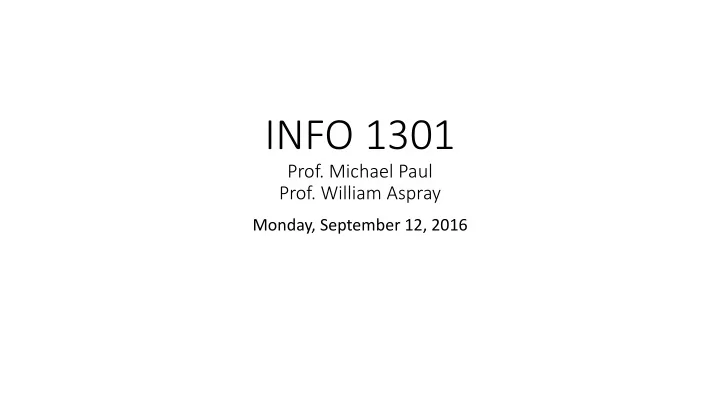

INFO ¡1301 Prof. ¡Michael ¡Paul Prof. ¡William ¡Aspray Monday, ¡September ¡12, ¡2016
Topics ¡for ¡Today • Describing ¡Data • Mean, ¡median, ¡and ¡mode • Dot ¡plots • Histograms
Measures ¡of ¡Central ¡Tendency ¡-‑ Mean Want ¡a ¡single ¡value ¡that ¡identifies ¡the ¡central ¡position ¡within ¡a ¡data ¡ set. ¡Three ¡common ¡choices: • (Arithmetic) ¡Mean ¡[aka ¡the ¡average] ¡– sum ¡of ¡all ¡the ¡data ¡points ¡divided ¡by ¡ the ¡number ¡of ¡data ¡points • Example ¡1: ¡1,2, ¡4, ¡4, ¡5, ¡9 ¡is ¡a ¡data ¡set. ¡The ¡mean ¡is ¡(1+2+4+4+5+8)/6 ¡= ¡25/6 ¡or ¡ approximately ¡4.17 • Note ¡that ¡the ¡mean ¡is ¡not ¡one ¡of ¡the ¡numbers ¡that ¡appeared ¡in ¡the ¡data ¡set • When ¡not ¡to ¡use ¡the ¡mean ¡– when ¡there ¡are ¡outliers • Example ¡2: ¡ ¡staff ¡salary ¡(thousands ¡of ¡dollars): ¡15, ¡18, ¡16, ¡14, ¡15, ¡15, ¡12, ¡17, ¡ 90, ¡95 ¡The ¡mean ¡is ¡$30.7 ¡thousand. ¡But ¡most ¡of ¡the ¡salaries ¡are ¡in ¡the ¡12-‑18K ¡ range. ¡What ¡happened?
Measures ¡of ¡Central ¡Tendency ¡-‑ Median • Median ¡= ¡the ¡middle ¡score • Procedure: ¡order ¡the ¡data ¡in ¡ascending ¡order; ¡if ¡an ¡odd ¡number ¡of ¡data ¡ points, ¡pick ¡the ¡middle ¡one; ¡if ¡an ¡even ¡number ¡of ¡data ¡points, ¡average ¡the ¡ two ¡middle ¡ones • Example ¡3: ¡Data ¡set ¡is ¡65, ¡55, ¡89, ¡56, ¡35, ¡14, ¡56, ¡55, ¡87, ¡45, ¡92 Reorder ¡as: ¡14, ¡35, ¡45, ¡55, ¡55, ¡ 56, 56, ¡65, ¡87, ¡89, ¡92 Median ¡is ¡56. • Example ¡4: ¡11, ¡19, ¡26, ¡24, ¡17, ¡3 Reorder ¡as ¡3,11 ,17 , 19 ,24,26 Median ¡= ¡(17+19)/2 ¡= ¡18
Measure ¡of ¡Central ¡Tendency ¡-‑ Mode • Mode ¡= ¡most ¡common ¡value ¡in ¡the ¡data ¡set • Often ¡used ¡for ¡categorical ¡data ¡when ¡we ¡want ¡to ¡know ¡the ¡most ¡common ¡ category • Example ¡5: ¡Transportation ¡to ¡campus: ¡car ¡(10), ¡ bus ¡(23), ¡ walk ¡(8), ¡bicycle ¡ (13), ¡skateboard ¡(9) • Example ¡6: ¡Favorite ¡baseball ¡team ¡of ¡sample ¡of ¡citizens ¡of ¡New ¡Haven, ¡CT: ¡ Yankees ¡(11), ¡Red ¡Sox ¡(11), ¡Cubs ¡(3), ¡Phillies ¡(2), ¡Rangers ¡(1), ¡Dodgers ¡(3), ¡ Giants ¡(3) ¡Braves ¡(3) ¡– Which ¡mode ¡is ¡best? • Example ¡7: ¡Weight ¡of ¡students ¡in ¡this ¡class ¡to ¡the ¡tenth ¡of ¡a ¡kilogram ¡– 20 ¡ different ¡values ¡(even ¡though ¡some ¡close) ¡so ¡no ¡mode ¡– Mode ¡rarely ¡used ¡ with ¡continuous ¡data.
3 ¡Measures ¡of ¡Central ¡Tendency • What ¡is ¡best ¡measure ¡of ¡central ¡tendency? • Depends ¡entirely ¡on ¡the ¡application • Mode ¡used ¡with ¡(non-‑ordinal, ¡i.e. ¡nominal) ¡categorical ¡data ¡but ¡not ¡often ¡ with ¡numerical ¡data; ¡it ¡is ¡the ¡least ¡used ¡measure. • Continuous ¡numerical ¡data ¡seldom ¡uses ¡a ¡mode ¡because ¡there ¡are ¡typically ¡ few ¡repeats ¡of ¡the ¡same ¡value ¡in ¡the ¡data ¡set. • Debated ¡question ¡whether ¡there ¡can ¡be ¡a ¡mean ¡for ¡ordinal ¡categorical ¡data. ¡ Some ¡people ¡report ¡means ¡on ¡Likert ¡scales, ¡but ¡other ¡statisticians ¡question ¡its ¡ meaningfulness. • Mean, ¡median, ¡and ¡mode ¡– or ¡two ¡of ¡them ¡– sometimes ¡the ¡same. ¡These ¡are ¡ cases ¡of ¡high ¡regularity ¡of ¡the ¡data ¡set.
Frequency ¡of ¡Categorical ¡Data ¡-‑ Dotplots • Dotplots – each ¡dot ¡represents ¡an ¡instance ¡of ¡a ¡particular ¡value ¡of ¡a ¡ categorical ¡variable ¡[regular, ¡stacked] • Dotplot itself ¡provides ¡a ¡visual ¡representation ¡of ¡the ¡frequency ¡of ¡ values ¡of ¡a ¡categorical ¡variable • Favorite ¡color ¡of ¡students ¡in ¡our ¡class ¡(ROYGBIV) ¡– make ¡the ¡dotplot • Dotplots good ¡with ¡small ¡data ¡sets ¡but ¡not ¡with ¡large ¡data ¡sets ¡– just ¡ a ¡big ¡blur ¡with ¡large ¡data ¡sets
Density ¡of ¡Data ¡-‑ Histograms • For ¡bigger ¡data ¡sets ¡(both ¡categorical ¡and ¡numerical), ¡we ¡can ¡put ¡the ¡ individual ¡data ¡points ¡into ¡bins ¡and ¡count ¡the ¡number ¡of ¡items ¡in ¡each ¡bin • Gives ¡us ¡a ¡sense ¡of ¡the ¡density ¡of ¡data ¡– higher ¡bars ¡where ¡the ¡data ¡are ¡ more ¡common. • Remember ¡the ¡email50 ¡data ¡set ¡discussed ¡in ¡the ¡book ¡in ¡section ¡1.2.1 ¡(p. ¡ 10)? ¡We ¡had ¡data ¡on ¡the ¡number ¡of ¡characters ¡in ¡each ¡of ¡these ¡50 ¡emails ¡ from ¡2012. ¡ • Place ¡them ¡in ¡bins ¡that ¡are ¡5000 ¡characters ¡wide. • You ¡get: ¡19 ¡(0-‑5), ¡12 ¡(5-‑10), ¡6 ¡(10-‑15), ¡2 ¡(15-‑20), ¡3 ¡(20-‑25), ¡5 ¡(25-‑30), ¡…, ¡0 ¡ (55-‑60), ¡1 ¡(60-‑65) ¡[convention ¡on ¡what ¡to ¡do ¡at ¡boundaries] • See ¡histogram ¡in ¡Fig ¡1.22 ¡(p. ¡31) ¡in ¡textbook
Shape ¡of ¡Data • Histograms ¡give ¡visual ¡clues ¡to ¡skewing • Right ¡skewed ¡– smaller ¡and ¡longer ¡to ¡right • Left ¡skewed • Symmetric ¡– trail ¡off ¡similarly ¡in ¡both ¡directions • Unimodal, ¡bimodal, ¡multimodal ¡– number ¡of ¡peaks
Class ¡Exercise • We ¡will ¡calculate ¡the ¡mean, ¡median, ¡and ¡mode ¡of ¡the ¡salaries ¡of ¡Scholars ¡in ¡ Residence ¡on ¡the ¡CU ¡Boulder ¡campus ¡last ¡academic ¡year. • Go ¡to ¡https://www.cu.edu/budgetpolicy/cu-‑data • Click ¡on ¡Faculty ¡and ¡Staff • Click ¡on ¡online ¡database ¡under ¡Faculty ¡and ¡Staff ¡salaries • At ¡the ¡bottom ¡of ¡the ¡page ¡enter ¡599 ¡in ¡the ¡box ¡and ¡hit ¡the ¡return ¡key, ¡ which ¡will ¡take ¡you ¡to ¡page ¡599 ¡of ¡the ¡database • Write ¡the ¡data ¡about ¡Scholars ¡in ¡Residence ¡from ¡p. ¡599 ¡and ¡p. ¡600 ¡into ¡ Minitab ¡Express ¡(get ¡to ¡p. ¡600 ¡from ¡p. ¡599 ¡by ¡using ¡the ¡single ¡arrow ¡at ¡the ¡ bottom ¡of ¡the ¡page ¡of ¡the ¡spreadsheet) • Use ¡Minitab ¡Express ¡to ¡calculate ¡the ¡mean, ¡median, ¡and ¡mode, ¡and ¡make ¡a ¡ dot ¡plot ¡and ¡histogram ¡of ¡this ¡data.
Recommend
More recommend